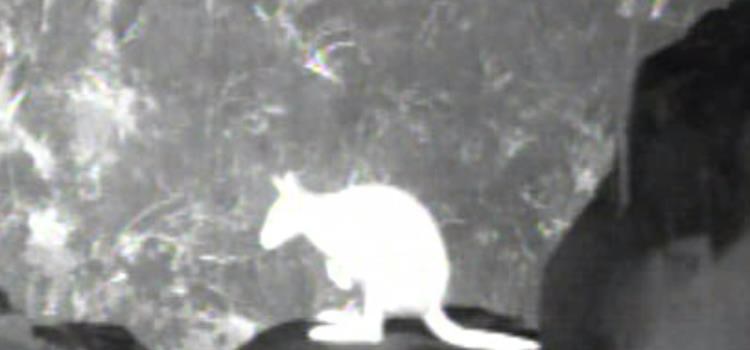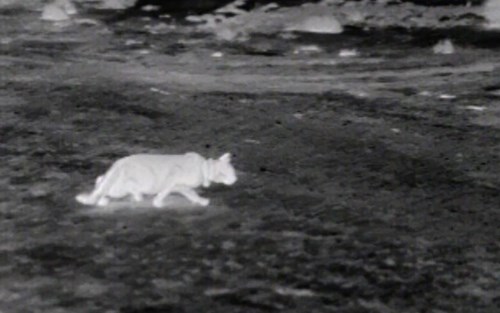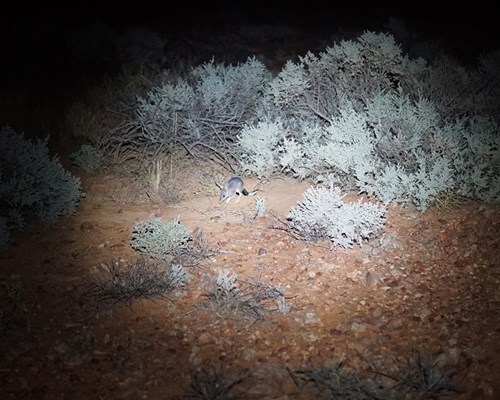
Research in Brief
Traditional techniques for monitoring wildlife such as trapping are often too expensive, inefficient or impractical for widespread use. New technologies and new advances in survey methods have the potential to provide data that are more accurate for lower costs.
Thermal cameras may be a useful tool to improve detections and thus the rigour of monitoring programs; however, they are an emerging technology and very little is known of their utility across the full range of Australian species and habitats. This project will investigate which species, habitats and circumstances thermal cameras are likely to be of most use for.
A thermal camera image of a feral cat. Photo: Arid Recovery
Why is the research needed?
Effectively monitoring threatened species and the impacts of management actions to protect them is constrained for many species by difficulties in detecting them. Many animals are cryptic by nature and are therefore difficult to detect and monitor effectively by traditional monitoring methods. To exacerbate the situation, a large part of Australia’s mammalian fauna is nocturnal. Traditional techniques for monitoring wildlife are often very expensive, inefficient and sometimes even logistically impossible.
Thermal cameras may be a useful tool to improve detections and thus the rigour of monitoring programs; however, they are an emerging technology and very little is known of their utility across the full range of Australian species and habitats. Thermal cameras have already been used in some circumstances to great effect. Unlike motion detection cameras, thermal imaging cameras allow the density of animals across the landscape to be estimated.
This project aims to address the gaps in our understanding of how thermal imaging can help with biodiversity monitoring across a range of species and habitats.
How will the research help?
This project seeks to establish which species, habitats and circumstances thermal cameras are likely to be of most use for. The results will be valuable for practitioners considering using thermal cameras for monitoring rare and cryptic species, as high-quality thermal cameras can be a major investment (>$5000). We will trial monitoring methods using thermal cameras with as many collaborators as possible across the country, and ultimately produce a resource that will be able to advise practitioners seeking to use the technology.
Our research will provide a comprehensive test of the utility of thermal cameras, and identify locations and species (both threatened native species and invasive ones) where the technology can improve the effectiveness of monitoring programs. Robust and repeatable methods for estimating populations of threatened species are an essential underpinning of every monitoring program. Similarly, reliable estimates of invasive predator populations are essential in evaluating the success or otherwise of methods aimed at mitigating their impacts.
This project will comprehensively test an emerging technology, thermal cameras, as a tool to improve monitoring programs for both threatened species and invasive predators.
A bilby detected during spot lighting at Arid Recovery Reserve, SA. Photo: Arid Recovery
What research activities are being undertaken?
The project will undertake five discrete trials comparing detection rates from thermal camera surveys to rates from traditional spotlighting methods.
The trials will take place in contrasting habitats across Australia targeting a range of species. The five habitats will be desert, rainforest, rocky ranges, temperate forest and tropical savanna.
Each trial will have at least 10 sessions of nocturnal animal survey with two observers, one observer searching using a spotlight and the other with a thermal camera. Sessions will be conducted only on nights below 20°C, and for a minimum of two hours. Both observers will stay within 5m of each other, and could travel on foot or by driving slowly (<20km/hr) with one observer in the front and one in the back of the vehicle.
We anticipate walking surveys in rainforests and vehicle-based surveys in deserts. For every animal detected, we will record which observer saw it first, distance from the observer (measured with a laser rangefinder), species, average temperature, and which methods detected the species. We will randomise the personnel conducting each method in order to measure observer bias associated with each method.
Who is involved?
The project will be undertaken by the University of Melbourne and the University of Tasmania, with assistance from Arid Recovery.
Where is the research happening?
Five trails will be conducted in contrasting habitats across Australia:
- Desert: will take place at Arid Recovery in South Australia, where we are monitoring bilbies, bettongs, rabbits, and native mice.
- Rainforest: will take place in the Atherton Tablelands, where we are trailing for aboreal mammals like tree-kangaroos.
- Rocky ranges: will take place in the Flinders Ranges, scanning for rock wallabies.
- Temperate forest: will take place in the Strathbogie ranges of Victoria.
- Topical savannah: location is yet to be determined.
When is the research happening?
The project will run from late 2015 to mid 2021.
Further Information
For more information contact:
José Lahoz-Monfort – jose.lahoz@unimelb.edu.au
Top image: A thermal camera image of a rock wallaby. Photo: Arid Recovery




